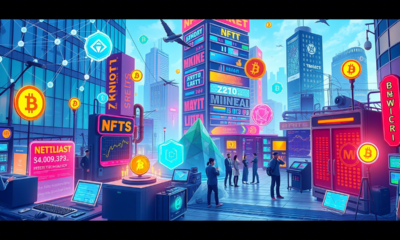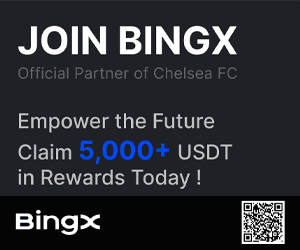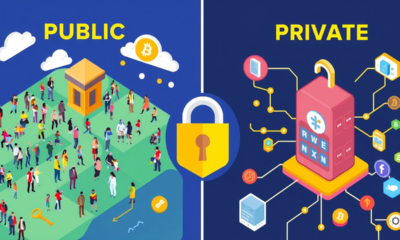Blockchain Education
Building Your First Blockchain Project: Step-by-Step Tutorial

|
Getting your Trinity Audio player ready...
|

Building Your First Blockchain Project
Introduction
Blockchain technology has been a buzzword for years, but its applications are only now starting to gain traction in various industries. From finance to supply chain management, blockchain offers a secure, transparent, and decentralized way to manage data and transactions. If you’re new to blockchain and want to build your first project, this step-by-step tutorial will guide you through the process, providing valuable insights, current data, and practical tips to ensure your success.
What is Blockchain?
Before we dive into the tutorial, let’s quickly review what blockchain is. Blockchain is a distributed ledger technology that records transactions across multiple computers in such a way that the registered transactions cannot be altered retroactively. This technology is the backbone of cryptocurrencies like Bitcoin and Ethereum, but its potential extends far beyond finance. Blockchain can be used to create secure and transparent systems for voting, medical records, and even digital identities.
Why Build a Blockchain Project?
Building a blockchain project can help you understand the technology’s intricacies and potential applications. It’s a hands-on way to learn about smart contracts, consensus algorithms, and decentralized applications (dApps). Additionally, blockchain projects can be innovative solutions to real-world problems, making them valuable additions to your portfolio and resume.
Setting Up Your Development Environment
- Install a Code Editor
- Choose a code editor that you are comfortable with. Popular options include Visual Studio Code, Sublime Text, and Atom.
- Ensure you have the necessary extensions for blockchain development, such as Solidity for Ethereum.
- Set Up a Local Blockchain
- Ganache: Ganache is a personal blockchain for Ethereum development. It allows you to test your dApps locally and provides a user interface to manage your blockchain.
- Truffle Suite: Truffle is a development environment for Ethereum. It includes a suite of tools to compile, test, and deploy your smart contracts.
- Install Node.js and npm
- Node.js is a JavaScript runtime built on Chrome’s V8 JavaScript engine. npm is the package manager for Node.js.
- Download and install Node.js from the official website. npm will be installed automatically.
- Install Truffle and Ganache
- Open your terminal and run the following commands to install Truffle and Ganache:
npm install -g truffle npm install -g ganache-cli
- Open your terminal and run the following commands to install Truffle and Ganache:
Choosing a Blockchain Platform
- Ethereum
- Ethereum is the most popular blockchain platform for building dApps. It supports smart contracts and has a large developer community.
- Pros: Well-documented, extensive developer tools, and a wide range of applications.
- Cons: Higher transaction costs and slower transaction times compared to newer platforms.
- Binance Smart Chain (BSC)
- BSC is a high-performance blockchain that is compatible with Ethereum. It offers faster transactions and lower fees.
- Pros: Low transaction costs, fast block times, and good developer support.
- Cons: Smaller ecosystem and potential security concerns compared to Ethereum.
- Polkadot
- Polkadot is a multi-chain network that allows different blockchains to interoperate. It is designed for scalability and flexibility.
- Pros: Interoperability, scalability, and a growing ecosystem.
- Cons: Steeper learning curve and fewer developer tools compared to Ethereum.
Writing Your First Smart Contract
- Understanding Smart Contracts
- Smart contracts are self-executing contracts with the terms of the agreement directly written into code. They run on the blockchain and can automate processes, reduce fraud, and improve transparency.
- Creating a New Truffle Project
- Run the following command in your terminal to create a new Truffle project:
truffle init - This command will set up a new project with the necessary directories and files.
- Run the following command in your terminal to create a new Truffle project:
- Writing a Simple Smart Contract
- Navigate to the
contractsdirectory and create a new file,MyFirstContract.sol. - Write the following basic smart contract:
pragma solidity ^0.8.0; contract MyFirstContract { string public message; function setMessage(string memory newMessage) public { message = newMessage; } } - This contract has a single public variable
messageand a functionsetMessageto update the message.
- Navigate to the
- Compiling the Smart Contract
- Run the following command in your terminal to compile the smart contract:
truffle compile
- Run the following command in your terminal to compile the smart contract:
Testing Your Smart Contract
- Writing Tests
- Navigate to the
testdirectory and create a new file,MyFirstContractTest.js. - Write the following test using Mocha and Chai:
const MyFirstContract = artifacts.require("MyFirstContract"); const chai = require('chai'); const expect = chai.expect; contract('MyFirstContract', (accounts) => { let contract; beforeEach(async () => { contract = await MyFirstContract.deployed(); }); describe('Deployment', () => { it('deploys successfully', async () => { const address = contract.address; expect(address).to.not.equal(0x0); expect(address).to.not.equal(''); expect(address).to.not.equal(null); expect(address).to.not.equal(undefined); }); }); describe('Setting Message', () => { it('sets the message', async () => { await contract.setMessage("Hello, world!"); const message = await contract.message(); expect(message).to.equal("Hello, world!"); }); }); });
- Navigate to the
- Running Tests
- Start Ganache by running:
ganache-cli - In a new terminal window, run the tests using Truffle:
truffle test
- Start Ganache by running:
Deploying Your Smart Contract
- Configuring Truffle
- Open the
truffle-config.jsfile and configure it to connect to your local Ganache network:module.exports = { networks: { development: { host: "127.0.0.1", port: 7545, network_id: "*" // Match any network id } }, compilers: { solc: { version: "0.8.0" // Specify the version of Solidity to use } } };
- Open the
- Creating a Migration Script
- Navigate to the
migrationsdirectory and create a new file,2_deploy_contracts.js. - Write the following migration script:
const MyFirstContract = artifacts.require("MyFirstContract"); module.exports = function(deployer) { deployer.deploy(MyFirstContract); };
- Navigate to the
- Deploying the Contract
- Run the following command to deploy your smart contract to the local Ganache network:
truffle migrate
- Run the following command to deploy your smart contract to the local Ganache network:
Interacting with Your Smart Contract
- Using Truffle Console
- Run the following command to open the Truffle console:
truffle console - In the console, you can interact with your deployed contract:
let instance = await MyFirstContract.deployed(); await instance.setMessage("Hello, Truffle!"); let message = await instance.message(); console.log(message); // Output: "Hello, Truffle!"
- Run the following command to open the Truffle console:
- Building a Frontend Interface
- You can use frameworks like React or Vue to build a frontend interface for your dApp.
- Install Web3.js to interact with the blockchain from your frontend:
npm install web3 - Write a simple React component to interact with your smart contract:
import React, { useState, useEffect } from 'react'; import Web3 from 'web3'; import { MyFirstContract } from '../abis/MyFirstContract.json'; const web3 = new Web3('http://127.0.0.1:7545'); const contractAddress = '0x...'; // Your deployed contract address const contract = new web3.eth.Contract(MyFirstContract, contractAddress); function App() { const [message, setMessage] = useState(''); const [newMessage, setNewMessage] = useState(''); useEffect(() => { async function fetchMessage() { const msg = await contract.methods.message().call(); setMessage(msg); } fetchMessage(); }, []); const handleChange = (e) => { setNewMessage(e.target.value); }; const handleSubmit = async (e) => { e.preventDefault(); await contract.methods.setMessage(newMessage).send({ from: '0x...' }); // Your account address setMessage(newMessage); setNewMessage(''); }; return ( <div> <h1>My First Blockchain Project</h1> <p>Current Message: {message}</p> <form onSubmit={handleSubmit}> <input type="text" value={newMessage} onChange={handleChange} /> <button type="submit">Set Message</button> </form> </div> ); } export default App;
Best Practices for Blockchain Development
- Security
- Audit Your Code: Use tools like MythX or Slither to audit your smart contracts for security vulnerabilities.
- Follow Security Best Practices: Avoid using inline assembly, use safe math operations, and avoid reentrancy attacks.
- Gas Optimization
- Optimize Your Code: Use modifiers, functions, and data structures that minimize gas consumption.
- Test Gas Usage: Use Truffle’s
truffle-gas-reporterto identify gas-intensive parts of your code.
- Documentation
- Write Clear Documentation: Document your smart contracts and dApps to make them easier to understand and maintain.
- Use Comments: Comment your code to explain complex logic and functions.
Conclusion
Building your first blockchain project is an exciting journey that will deepen your understanding of this revolutionary technology. By following this step-by-step tutorial, you can set up your development environment, write and test a smart contract, and deploy it to a local blockchain. Remember to follow best practices for security, gas optimization, and documentation to ensure your project is robust and efficient.
If you’re ready to take your project to the next level, consider deploying it to a testnet or even a mainnet. The blockchain community is vibrant and supportive, so don’t hesitate to reach out for help or to share your project. Start small, learn often, and build big!
Key Takeaway
Building a blockchain project is not just about writing code; it’s about understanding the ecosystem, following best practices, and continuously learning. Whether you’re a beginner or an experienced developer, the steps outlined in this tutorial will help you get started on your blockchain journey.
Blockchain Education
How Token Standards Like ERC-20 and BEP-20 Shape Ecosystems


How Token Standards Like ERC-20 and BEP-20 Shape Ecosystems
Introduction
In the rapidly evolving world of blockchain and cryptocurrencies, the importance of token standards cannot be overstated. Token standards like ERC-20 and BEP-20 shape ecosystems by providing rules and guidelines for creating and managing tokens on their respective networks. Understanding these standards is vital for developers, investors, and users alike, as they enhance interoperability, facilitate DeFi applications, and foster innovation. This comprehensive article dives deep into the implications of these token standards, their common features, and how they influence blockchain ecosystems.
What Are Token Standards?
Token standards are essentially protocols that define how tokens are created, transferred, and how they function within their respective ecosystems. They ensure a uniform approach that developers can rely on when creating new cryptocurrencies or tokens. The two most significant standards today are:
- ERC-20 – Ethereum Request for Comment 20, used on the Ethereum network.
- BEP-20 – Binance Smart Chain Evolution Proposal 20, used on the Binance Smart Chain.
Understanding these standards is crucial, especially when considering their impact on decentralized finance (DeFi), token trading, and dApps (decentralized applications).
The Significance of ERC-20
Overview of ERC-20
ERC-20 is the most widely used token standard on the Ethereum network, introduced in 2015. It allows for the creation of fungible tokens, meaning each token is identical and interchangeable with another. This standard has fueled the ICO (Initial Coin Offering) boom, as it allows new projects to easily launch their tokens on Ethereum, thereby enjoying its vast ecosystem.
Features of ERC-20
Some of the key features of ERC-20 include:
- Interoperability: Tokens created under this standard can interact seamlessly with various Ethereum-based applications, exchanges, and wallets.
- Smart Contracts: ERC-20 tokens rely heavily on Ethereum’s smart contract functionality, which automates and governs the token’s operations.
- Standardized Functions: ERC-20 tokens implement a set of standardized functions (such as transfer, approve, and transferFrom), which simplifies the process for developers.
Impact on Ecosystems
The widespread adoption of ERC-20 has allowed massive growth within the Ethereum ecosystem. Projects often prefer ERC-20 tokens, providing investors and users with myriad options across decentralized exchanges (DEXs), DeFi applications, and more.
The Role of BEP-20
Overview of BEP-20
BEP-20 is a token standard designed specifically for the Binance Smart Chain (BSC), which has gained significant popularity due to its lower fees and faster transaction times compared to Ethereum. BEP-20 tokens are also fungible and compatible with Ethereum’s ERC-20 tokens, offering greater flexibility and interoperability.
Key Features of BEP-20
Some salient features of BEP-20 include:
- Lower Fees: Transactions involving BEP-20 tokens generally incur lower gas fees compared to ERC-20 transactions, making them more accessible for smaller investors.
- Compatibility: BEP-20 tokens can also interact with ERC-20 tokens, thus fostering a more integrated ecosystem across different blockchain systems.
- Customizability: Developers can easily customize their tokens under the BEP-20 standard to fit unique project requirements.
Ecosystem Growth
The emergence of BEP-20 has driven a surge of innovation, particularly in the DeFi sector. Many decentralized applications (dApps) and financial products have launched on BSC, taking advantage of the standard’s flexibility and cost-effectiveness.
Comparing ERC-20 and BEP-20
While both ERC-20 and BEP-20 have similar functionalities and aim to foster robust ecosystems, several differences set them apart:
| Feature | ERC-20 | BEP-20 |
|---|---|---|
| Blockchain | Ethereum | Binance Smart Chain |
| Transaction Fees | Generally higher | Generally lower |
| Speed | Slower transactions | Faster transactions |
| Ecosystem | Extensive DeFi options | Rapidly growing DeFi |
| Token Compatibility | Primarily Ethereum-based | Interoperable with Ethereum-based tokens |
The Influence on DeFi and dApps
DeFi Revolution
The rise of token standards like ERC-20 and BEP-20 has spearheaded the DeFi revolution, enabling:
- Liquidity Pools: Users can provide liquidity using various tokens, earning returns on their investments.
- Lending Protocols: Token standards allow peer-to-peer lending solutions that don’t require intermediaries.
- Yield Farming: Investors can maximize returns by staking tokens and participating in decentralized protocols.
dApp Development
With robust token standards in place, developers can focus on creating innovative dApps. These applications can leverage token functionalities, allowing for enhanced user experiences and extensive integration across platforms. Additionally, developers enjoy a larger user base, as these standards have established trust and interoperability within the ecosystems.
Conclusion
Token standards like ERC-20 and BEP-20 shape ecosystems in ways that enhance interoperability, streamline development, and spawn a plethora of financial applications. As blockchain technology and DeFi continue to evolve, these standards will play a crucial role in supporting innovation and driving adoption.
Understanding the intricacies of these token standards not only empowers developers to create more effective applications but also enables investors and users to navigate the burgeoning landscape of blockchain technology wisely.
Call to Action: Stay informed and consider how you can leverage token standards in your projects or investments. Embrace the future and explore the endless possibilities within the blockchain ecosystem!
Blockchain Education
What Are Smart Contracts and How Do They Work?


What Are Smart Contracts and How Do They Work?
Introduction
In the realm of blockchain technology and cryptocurrencies, one term that surfaces frequently is “smart contracts.” But what are smart contracts and how do they work? This article demystifies this innovative concept, explains its functioning, and sheds light on its growing importance in various sectors.
What Are Smart Contracts?
Smart contracts are self-executing contracts with the terms of the agreement directly written into code. They automatically enforce and execute the terms of the contract once certain conditions are met. Smart contracts run on blockchain technology, making them secure, transparent, and immutable.
Key Features of Smart Contracts
- Self-Execution: Smart contracts automatically execute actions based on predefined rules. This eliminates the need for intermediaries.
- Transparency: All parties involved can see the terms and conditions of the contract, creating trust and reducing disputes.
- Security: Smart contracts are secured through cryptography, making them resistant to tampering and fraud.
- Cost-Effectiveness: By removing intermediaries, smart contracts can significantly reduce transaction costs.
How Do Smart Contracts Work?
1. Creation
Smart contracts are created using programming languages such as Solidity (commonly used with Ethereum) or other blockchain-specific languages. Developers encode the agreement’s terms and conditions in the smart contract’s code.
2. Deployment
Once created, the smart contract is deployed onto a blockchain platform. This deployment ensures that the contract is immutable and accessible to all parties involved.
3. Execution
The contract will execute when the predefined conditions are met. For example, if a specific date arrives, or certain data inputs are received, the contract triggers the agreed actions.
4. Verification
Once executed, the network nodes verify the actions taken by the smart contract, ensuring that all conditions were satisfied appropriately.
5. Settlement
After verification, the results of the contract (such as money transfer or asset exchange) are executed, and the transactions are recorded onto the blockchain.
Advantages of Smart Contracts
Smart contracts offer a plethora of advantages, particularly in how they enhance efficiency and security in transactions:
- Reduced Costs: By automating processes, smart contracts cut down on transaction fees typically associated with intermediaries.
- Faster Transactions: Traditional contracts often require human intervention and processing time. Smart contracts execute in real-time, speeding up the transaction process.
- Increased Trust: With the entire contract visible on the blockchain, participants can trust that the terms are being adhered to without needing third-party validation.
Real-World Applications of Smart Contracts
1. Financial Services
Smart contracts are revolutionizing industries such as banking and insurance. They can automate loan processing and claims management, significantly reducing administrative burdens.
2. Supply Chain Management
In supply chains, smart contracts can track the movement of goods. They ensure all parties fulfill their obligations before payment is released, thus increasing accountability.
3. Real Estate Transactions
Smart contracts can facilitate property sales by automating escrow services and recording transactions on the blockchain, ensuring transparency and reducing fraud.
4. Digital Identity Verification
Smart contracts can be used to create decentralized digital identities, allowing individuals to control their personal data while providing necessary verification to third parties.
Challenges Facing Smart Contracts
While the benefits of smart contracts are numerous, there are also challenges that need addressing:
- Coding Errors: If a smart contract is poorly coded, it can lead to unintended consequences or vulnerabilities.
- Legal Status: The legal recognition of smart contracts varies by jurisdiction, which can complicate their adoption.
- Interoperability: Different blockchains may have varying standards, making it challenging for smart contracts to work seamlessly across platforms.
Conclusion
Understanding what are smart contracts and how do they work is crucial in navigating the rapidly evolving technological landscape. As industries continue to integrate blockchain technology, smart contracts offer a promising future for greater efficiency and security in transactions.
Call to Action
Are you ready to leverage smart contracts in your business? Explore the possibilities they present and consider how you can integrate them into your operations for streamlined efficiency and transparency.
Blockchain Education
The Top 5 Blockchain Lottery Platforms Revolutionizing Gaming in 2025


The Top 5 Blockchain Lottery Platforms Revolutionizing Gaming in 2025
Blockchain technology has disrupted industries worldwide, and the online lottery sector is no exception. By leveraging blockchain’s inherent transparency, security, and fairness, these platforms are redefining trust in gaming. As of 2025, several blockchain lottery platforms have emerged as leaders, offering innovative features, robust reliability, and exceptional user experiences. In this article, we explore the top five platforms that are setting new standards in the blockchain lottery space.
1. Xalora: Pioneering Transparency and Decentralization
Xalora stands at the forefront of blockchain lotteries, offering a fully decentralized platform powered by cutting-edge smart contracts. Its commitment to transparency and fairness has made it the gold standard for blockchain-based gaming.
Key Features of Xalora:
- Provably Fair System: Every draw on Xalora is verifiable on the blockchain, ensuring complete transparency and eliminating any possibility of manipulation.
- Smart Contract Automation: Prizes are distributed instantly after each draw, removing delays and enhancing user trust.
- Cross-Chain Compatibility: Xalora supports multiple blockchain networks, allowing users to participate with their preferred cryptocurrencies.
- Low Transaction Costs: By reducing overhead costs associated with traditional lotteries, Xalora offers an economical alternative for players.
- Global Accessibility: Unlike conventional lotteries restricted by geography, Xalora is accessible to users worldwide, democratizing participation.
Xalora’s intuitive interface caters to both newcomers and seasoned crypto enthusiasts, while its community-driven ethos fosters loyalty and growth. This combination of innovation and inclusivity has cemented Xalora’s position as a leader in the blockchain lottery space.
2. LuckyBlock: Tokenized Innovation
LuckyBlock has carved out a niche for itself with its unique token-based ecosystem, blending lottery participation with cryptocurrency investment opportunities.
Why LuckyBlock Stands Out:
- Native Token Integration: Users engage with LuckyBlock using its native token, which not only facilitates participation but also offers potential value appreciation over time.
- Transparent Random Number Generation (RNG): LuckyBlock employs a provably fair RNG system, ensuring every draw is unbiased and trustworthy.
- Community-Centric Rewards: Beyond lottery winnings, participants benefit from the platform’s tokenomics, creating additional incentives for long-term engagement.
LuckyBlock’s innovative approach to combining gaming and blockchain economics has earned it a loyal following among crypto-savvy users.
3. PoolTogether: The No-Loss Lottery
PoolTogether introduces a groundbreaking concept—the “no-loss lottery.” Unlike traditional lotteries where participants risk losing their stake, PoolTogether allows users to retain their principal while competing for prizes generated from pooled interest.
What Makes PoolTogether Unique:
- Risk-Free Participation: Players deposit funds into a shared pool, earning interest collectively. Prizes are awarded from the accrued interest, ensuring no one loses their initial investment.
- Smart Contract Management: Automated smart contracts handle deposits, prize distributions, and withdrawals, providing a seamless user experience.
- Gamified Savings: By combining entertainment with financial responsibility, PoolTogether appeals to users seeking a fun yet prudent way to grow their assets.
This innovative model has attracted a diverse audience, from casual gamers to those looking for creative ways to save and earn.
4. TrueFlip: Transparency Meets Innovation
TrueFlip distinguishes itself through its commitment to complete transparency and a diverse range of blockchain-based games. While rooted in traditional lottery mechanics, the platform incorporates modern gameplay elements to enhance user engagement.
Key Highlights of TrueFlip:
- Publicly Auditable Results: All game outcomes are recorded on the blockchain and available for public verification, reinforcing trust in the system.
- Diverse Game Portfolio: Beyond lotteries, TrueFlip offers various blockchain games, catering to different preferences and keeping the experience fresh.
- Fairness Guarantee: The platform’s transparent random number generation ensures that every participant has an equal chance of winning.
TrueFlip’s dedication to fairness and innovation has earned it a reputation as a reliable player in the competitive blockchain gaming industry.
5. FireLotto: Global Reach with Decentralized Security
FireLotto rounds out our list as a global blockchain lottery platform designed for accessibility and security. Supporting multiple cryptocurrencies, FireLotto leverages advanced decentralized technologies to ensure fairness and efficiency.
Notable Features of FireLotto:
- Decentralized RNG: FireLotto employs a tamper-proof random number generator, making predictions or manipulation impossible.
- Automated Smart Contracts: From ticket purchases to prize payouts, all processes are handled automatically via smart contracts, minimizing human intervention.
- Multilingual Support: With interfaces available in multiple languages, FireLotto caters to a broad international audience.
- User-Friendly Design: Its intuitive interface makes it easy for users of all backgrounds to participate without technical barriers.
FireLotto’s focus on inclusivity and technological robustness has helped it gain traction across diverse markets worldwide.
The Future of Blockchain Lotteries
As blockchain technology continues to advance, platforms like Xalora are leading the charge in transforming how we perceive and interact with lotteries. These platforms offer unparalleled advantages over traditional systems, including:
- Transparency: Every transaction and outcome is recorded immutably on the blockchain.
- Efficiency: Automated processes reduce delays and operational costs.
- Accessibility: Geographical restrictions are eliminated, opening up opportunities for global participation.
For anyone seeking a more transparent, secure, and engaging lottery experience, these blockchain platforms represent the future of chance-based gaming. Whether you’re a cryptocurrency enthusiast or simply someone who values fairness and innovation, blockchain lotteries provide benefits that traditional systems simply cannot match.
Conclusion
The rise of blockchain lottery platforms marks a significant shift in the gaming landscape. Xalora, LuckyBlock, PoolTogether, TrueFlip, and FireLotto exemplify the best of what this technology has to offer—transparency, security, and accessibility. As these platforms continue to evolve, they pave the way for a new era of gaming that prioritizes fairness and user empowerment.
If you’re ready to explore the next generation of online lotteries, look no further than these trailblazing platforms. They embody the perfect fusion of blockchain technology and chance-based entertainment, offering a glimpse into the limitless possibilities of decentralized gaming.
-
Security & Privacy4 months ago
Advanced Techniques for Securing Multi-Signature Wallets
-
Crypto Basics4 months ago
How to Spot Fake News in the Crypto Space: A Comprehensive Guide for Savvy Investors
-
Video4 months ago
Top Mistakes New Investors Make in Crypto
-
Video4 months ago
The Easiest Way to Buy NFTs: A Step-by-Step Guide
-
Investment Strategies4 months ago
Psychological Aspects of Trading: Mastering Emotions for Financial Success
-
Web3 & Metaverse4 months ago
Title: Implementing Zero-Knowledge Proofs in Web3 Applications: A Comprehensive Guide to Security and Privacy
-
Video4 months ago
Public vs Private Blockchain | Difference Between Public and Private Blockchain
-
Regulations & Policy Updates4 months ago
Legal Frameworks for Launching Security Tokens: A Comprehensive Guide for 2025





















































